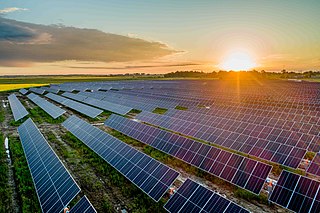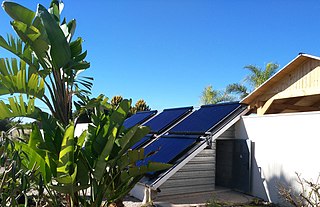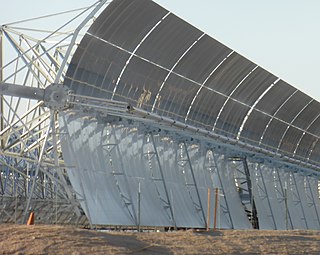
Hydropower, also known as water power, is the use of falling or fast-running water to produce electricity or to power machines. This is achieved by converting the gravitational potential or kinetic energy of a water source to produce power. Hydropower is a method of sustainable energy production.

Solar energy is radiant light and heat from the Sun that is harnessed using a range of technologies such as solar power to generate electricity, solar thermal energy including solar water heating, and solar architecture.

A solar furnace is a structure that uses concentrated solar power to produce high temperatures, usually for industry. Parabolic mirrors or heliostats concentrate light (Insolation) onto a focal point. The temperature at the focal point may reach 3,500 °C (6,330 °F), and this heat can be used to generate electricity, melt steel, make hydrogen fuel or nanomaterials.

Pumped-storage hydroelectricity (PSH), or pumped hydroelectric energy storage (PHES), is a type of hydroelectric energy storage used by electric power systems for load balancing. The method stores energy in the form of gravitational potential energy of water, pumped from a lower elevation reservoir to a higher elevation. Low-cost surplus off-peak electric power is typically used to run the pumps. During periods of high electrical demand, the stored water is released through turbines to produce electric power. Although the losses of the pumping process make the plant a net consumer of energy overall, the system increases revenue by selling more electricity during periods of peak demand, when electricity prices are highest. If the upper lake collects significant rainfall or is fed by a river then the plant may be a net energy producer in the manner of a traditional hydroelectric plant.

Solar thermal energy (STE) is a form of energy and a technology for harnessing solar energy to generate thermal energy for use in industry, and in the residential and commercial sectors.

Solar water heating (SWH) is heating water by sunlight, using a solar thermal collector. A variety of configurations is available at varying cost to provide solutions in different climates and latitudes. SWHs are widely used for residential and some industrial applications.

A parabolic trough is a type of solar thermal collector that is straight in one dimension and curved as a parabola in the other two, lined with a polished metal mirror. The sunlight which enters the mirror parallel to its plane of symmetry is focused along the focal line, where objects are positioned that are intended to be heated. In a solar cooker, for example, food is placed at the focal line of a trough, which is cooked when the trough is aimed so the Sun is in its plane of symmetry.

Grid energy storage is a collection of methods used for energy storage on a large scale within an electrical power grid. Electrical energy is stored during times when electricity is plentiful and inexpensive or when demand is low, and later returned to the grid when demand is high, and electricity prices tend to be higher.

The Solar Electric Light Fund (SELF) is a Washington, D.C. based nonprofit whose mission is to design and implement solar energy solutions to assist those living in energy poverty with their economic, educational, health care, and agricultural development. Since 1990, SELF has completed projects in more than 20 countries, using solar energy to power drip irrigation in Benin, health care in Haiti, telemedicine in the Amazon rainforest, online learning in South Africa, and microenterprise development in Nigeria.

Solar-powered pumps run on electricity generated by photovoltaic (PV) panels or the radiated thermal energy available from collected sunlight as opposed to grid electricity- or diesel-run water pumps. Generally, solar-powered pumps consist of a solar panel array, solar charge controller, DC water pump, fuse box/breakers, electrical wiring, and a water storage tank. The operation of solar-powered pumps is more economical mainly due to the lower operation and maintenance costs and has less environmental impact than pumps powered by an internal combustion engine. Solar pumps are useful where grid electricity is unavailable or impractical, and alternative sources do not provide sufficient energy.

Solar power in India is a fast developing industry as part of the renewable energy in India. The country's solar installed capacity was 53.997 GW as of 31 March 2022.

The developing nations of Africa are popular locations for the application of renewable energy technology. Currently, many nations already have small-scale solar, wind, and geothermal devices in operation providing energy to urban and rural populations. These types of energy production are especially useful in remote locations because of the excessive cost of transporting electricity from large-scale power plants. The applications of renewable energy technology has the potential to alleviate many of the problems that face Africans every day, especially if done in a sustainable manner that prioritizes human rights.

Solar Cookers International (SCI) is a 501(c)(3) nonprofit, non-governmental organization that works to improve human and environmental health by supporting the expansion of effective carbon-free solar cooking in world regions of greatest need. SCI leads through advocacy, research, and strengthening the capacity of the global solar cooking movement. SCI has consultative status with the United Nations Economic and Social Council (ECOSOC) and was founded in 1987.
The Kyoto Box is a solar cooker constructed from polypropylene with an acrylic plastic cover. The oven traps the suns rays, creating enough heat to cook or boil water.
The Sahara Forest Project aims to provide fresh water, food and renewable energy in hot, arid regions as well as re-vegetating areas of uninhabited desert. The founding team was composed of Seawater Greenhouse Ltd, Exploration Architecture, Max Fordham Consulting Engineers and the Bellona Foundation.

India is world's 3rd largest consumer of electricity and world's 3rd largest renewable energy producer with 38% of energy capacity installed in the year 2020 coming from renewable sources. Ernst & Young's (EY) 2021 Renewable Energy Country Attractiveness Index (RECAI) ranked India 3rd behind USA and China. In November 2021, India had a renewable energy capacity of 150 GW consisting of solar, wind, small hydro power, bio-mass, large hydro, and nuclear. India has committed for a goal of 450 GW renewable energy capacity by 2030.
In Guyana, the areas outside of the coastal plain are referred to as hinterland. Approximately twenty percent of the Guyanese population live in the hinterland. The population mostly consists of Amerindian communities who have little access to modern energy services such as electricity, light and modern fuels for cooking and transportation. This situation contrasts with the coastal plain, where there is access to the electricity grid. Several initiatives are in place to improve energy services in the hinterland.
Solar energy – radiant light and heat from the sun. It has been harnessed by humans since ancient times using a range of ever-evolving technologies. Solar energy technologies include solar heating, solar photovoltaics, solar thermal electricity and solar architecture, which can make considerable contributions to solving some of the most urgent problems that the world now faces.

Energy use in Rwanda is undergoing rapid change at the beginning of the 21st century.

Renewable energy in South Africa is energy generated in South Africa from renewable resources, those that naturally replenish themselves—such as sunlight, wind, tides, waves, rain, biomass, and geothermal heat. Renewable energy focuses on four core areas: electricity generation, air and water heating/cooling, transportation, and rural energy services. The energy sector in South Africa is an important component of global energy regimes due to the country's innovation and advances in renewable energy. South Africa's greenhouse gas (GHG) emissions is ranked as moderate and its per capita emission rate is higher than the global average. Energy demand within the country is expected to rise steadily and double by 2025.



















